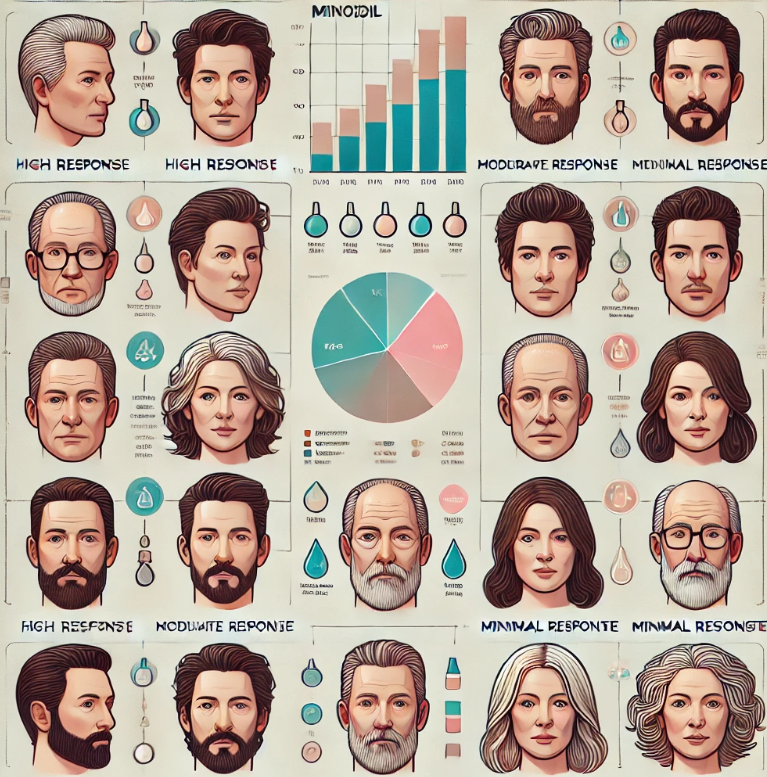Categories
- Blog (65)
The effectiveness response of minoxidil can vary significantly between individuals due to a variety of factors. These differences can influence how well a person responds to the treatment, the speed at which they see results, and the extent of hair regrowth. Here are some key factors that contribute to the variability in response to minoxidil:

Sensitivity of Hair Follicles: Individuals with hair follicles that are more sensitive to the effects of dihydrotestosterone (DHT) (especially in cases of androgenetic alopecia) may experience different levels of regrowth. While minoxidil stimulates growth, follicles severely affected by DHT may be less responsive.
Hereditary Patterns: Some people are genetically predisposed to respond better to certain treatments. If family members have had success with minoxidil, there’s a higher likelihood of positive results.
Androgenetic Alopecia: Minoxidil is most effective for people with early-stage androgenetic alopecia (male or female pattern baldness). Those with more advanced baldness or areas of complete hair loss (where follicles have been inactive for a long time) tend to respond less favorably.
Diffuse Thinning: Individuals with diffuse thinning (hair loss that spreads evenly across the scalp) often see better results than those with patchy bald spots, because the follicles are more uniformly affect and responsive.
Scarring Alopecia: Minoxidil is generally less effective for types of hair loss causedby scarring (where the follicle has been permanently damage) or autoimmune conditions like alopecia areata, though there may be some exceptions.
Younger Individuals: Minoxidil tends to work better for people who start treatment at a younger age, when their hair follicles are still relatively active. Younger users typically have more responsive hair follicles and may experience faster and more significant regrowth.
Older Individuals: As individuals age, hair follicles may become less responsive to stimulation, leading to slower or more modest results with minoxidil. However, age isn’t an absolute barrier; some older individuals still benefit from its use.
Recent Hair Loss: Minoxidil tends to be more effective for people who have experienced **recent hair loss** (within the last 5 years). Hair follicles that are newly inactive or miniaturized respond better than those that have been dormant for a longer time.
Long-Term Hair Loss: Those with long-standing baldness or hair thinning may see less regrowth, as hair follicles can become permanently inactive or scarred over time.
Adherence to Treatment: Some people experience less success because they are inconsistent in applying minoxidil or fail to use it properly (e.g., not applying it directly to the scalp or using too much/too little).
Frequency: Minoxidil is typically recommended to be used twice daily for optimal results. Those who use it less frequently may experience slower or less pronounced regrowth.
Healthy Scalp: A healthy scalp allows for better absorption of minoxidil and better follicular response. Individuals with conditions like seborrheic dermatitis, dandruff, or chronic scalp inflammation may experience reduced effectiveness unless those issues are address.
Scalp Irritation: Some people develop irritation or dryness from minoxidil use, which can affect their ability to continue treatment consistently, limiting results.
Men vs. Women: Men and women may respond differently to minoxidil. In men, minoxidil is more commonly used for androgenetic alopecia, and results are often seen on the vertex (crown) of the scalp. Women, on the other hand, may experience hair regrowth more diffusely across the scalp due to different hair loss patterns.
Strength of Solution: Men generally use a 5% strength minoxidil solution, while women are often prescribed the 2% solution to minimize potential side effects like facial hair growth. However, many women now use the 5% formulation with good results.
Hormonal Imbalances: Conditions like thyroid disorders or polycystic ovary syndrome (PCOS) can affect hair loss patterns and treatment responses. For individuals with such conditions, addressing the underlying issue can enhance the effectiveness of minoxidil.
Other Health Issues: Certain health problems that affect circulation or the immune system may reduce the effectiveness of minoxidil by impacting the hair follicles’ ability to respond to stimulation.
Rapid Responders: Some people may see improvements within 3 to 4 months of starting minoxidil, with visible regrowth or reduced shedding early on.
Slow Responders: Others may take 6 to 12 months to see noticeable changes. These individuals may have a slower hair growth cycle or follicles that take longer to respond to treatment.
Non-Responders: A minority of users may not respond to minoxidil at all, due to factors like advanced follicle miniaturization or genetic resistance.
Diet and Nutrition: Nutritional deficiencies (such as low levels of iron, biotin, or zinc) can affect hair growth. A balanced diet that supports hair health may improve the results of minoxidil treatment.
Stress Levels: High levels of chronic stress can lead to hair loss (telogen effluvium) and interfere with hair growth. Managing stress through lifestyle changes can enhance treatment success.
Combination Therapies: People who combine minoxidil with other hair growth treatments, like finasteride, PRP therapy, or low-level laser therapy, may experience better results compared to using minoxidil alone. These therapies target hair loss through different mechanisms, potentially boosting overall effectiveness.
Supplements and Topicals: Using supplements such as biotin, saw palmetto, or collagen can provide additional support for hair regrowth and improve minoxidil results.
The response to minoxidil is highly individualized. Factors like genetics, the type and severity of hair loss, age, scalp health, and adherence to the treatment regimen all influence how well a person responds. While many individuals see positive results with regular use, some may experience slower or less pronounced benefits.